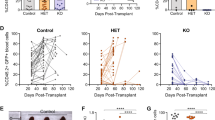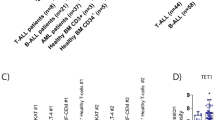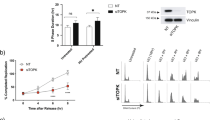Abstract
The contribution of oncogene amplification and/or overexpression to T-cell lymphoid neoplasms has only of late been established with the implication of the TCL1 and MTCP1 genes in T-cell malignancies. Our laboratory has recently discovered a novel oncogene, MCT-1, amplified in a T-cell lymphoma and mapped to chromosome Xq22-24. MCT-1 has been shown to decrease cell-doubling time, dramatically shortening the duration of G1 transit time and/or G1-S transition, and transforms NIH3T3 fibroblasts. Constitutive expression of MCT-1 results in a strong proliferative signal and is associated with deregulation of protein kinase-mediated G1/S phase checkpoints. In this study we analysed the level and subcellular localization of this novel cell cycle regulatory molecule as a function of cell cycle phase. In human lymphoid tumors expression of MCT-1 is constant throughout the cell cycle and remains cytoplasmic. Cells overexpressing MCT-1 have increased expression of cyclin D1 with dysregulation of the G1-S checkpoint. Both cyclin D1 and MCT-1 are involved in regulating passage of cells through the G1 phase of the cell cycle. Since prior work has shown that gamma irradiation induces cyclin D1 expression we investigated the induction of MCT-1 to DNA damaging agents. We demonstrate that increases in MCT-1 protein in irradiated human lymphoid cells do not occur at the mRNA level and do not require new protein synthesis.
This is a preview of subscription content, access via your institution
Access options
Subscribe to this journal
Receive 50 print issues and online access
$259.00 per year
only $5.18 per issue
Buy this article
- Purchase on Springer Link
- Instant access to full article PDF
Prices may be subject to local taxes which are calculated during checkout







Similar content being viewed by others
References
AltShul SF, Lipman DJ . 1990 Proc. Natl. Acad. Sci. USA 87: 5509–5513
Anderson G, Busso D, Poterszman A, Hwang JR, Wustz JM, Ripp R, Thiessy JM, Egly JM, Mosas D . 1997 EMBO J. 16: 958–967
Aravind L, Koonin EV . 1999 J. Mol. Evol. 48: 291–302
Ben-Yehuda D, Houldsworth J, Parsa NZ, Chaganti RSK . 1994 Br. J. Haematol. 86: 792–796
Berneman ZN, Gartenhaus RB, Reitz Jr MS, Blattner WA, Manns A, Hanchard B, Ikehara O, Gallo RC, Klotman ME . 1992 Proc. Natl. Acad. Sci. USA 89: 3005–3009
Blagosklonny MV, Fojo T . 1999 Int. J. Cancer 83: 151–156
Chuang LT, Lotzova E, Heath J, Cook KR, Munkarah A, Morris M, Wharton TJ . 1994 Cancer Research 54: 1286–1291
Dierov J, Prosniak M, Gallia G, Gartenhaus RB . 1999 J. Cell. Biochem. 74: 544–550
Epperly M, Berry L, Halloran A, Greenberger JS . 1995 Radiat Res. 143: 245–254
Gartenhaus RB, Wang P . 1995 Leukemia 9: 2082–2086
Lam MHC, Olsen SL, Rankin WA, Ho PWM, Martin TJ, Gillespie MT, Moseley JM . 1997 J. Cell. Physiol. 173: 433–446
Monni O, Joensuu H, Franssila K, Knuutila S . 1996 Blood 87: 5269–5278
Paulovich AG, Toczyski DP, Hartwell LH . 1997 Cell 88: 315–321
Pekarsky Y, Hallas C, Isobe M, Russo G, Croce CM . 1999 Proc. Natl. Acad. Sci. USA 96: 2949–2951
Petersen BO, Lukas J, Sorensen CS, Bartek J, Helin K . 1999 EMBO J. 18: 396–410
Poommipanit PB, Chen B, Oltvai ZN . 1999 J. Biol. Chem. 274: 1033–1039
Prosniak M, Dierov J, Okami K, Tilton B, Jameson B, Sawaya BE, Gartenhaus RB . 1998 Cancer Res. 58: 4233–2337
Reid RL, Lindholm PF, Mireskandari A, Dittmer J, Brady JN . 1993 Oncogene 8: 3029–3033
Sandberg AA, Berger CS . 1994 J. Urol. 151: 545–556
Scarpa A, Taruscio D, Scardoni M, Iosi F, Paradisi S, Ennas MG, Rigaud G, Moore PS, Menestrina F . 1999 Genes Chromosomes Cancer 26: 203–209
Sheikh MS, Fernandez-Salas E, Yu M, Hussain A, Dinman JD, Peltz SW, Huang Y, Fornace Jr AJ . 1999 J. Biol. Chem. 274: 16487–16493
Stern MH, Soulier J, Rosenzwajg M, Nakahara K, Canki-Klain N, Aurias A, Sigaux F, Kirsch IR . 1993 Oncogene 8: 2475–2483
Sugimoto J, Hatakeyama T, Narducci MG, Russo G, Isobe M . 1999 Cancer Res. 59: 2313–2317
Virgilio L, Narducci MG, Isobe M, Billips LG, Cooper MD, Croce CM, Russo G . 1994 Proc. Natl. Acad. Sci. USA 91: 12530–12534
Werner CA, Dohner H, Joos S, Trumper LH, Baudis M, Barth TF, Ott G, Moller P, Lichter P, Bentz M . 1997 Am. J. Pathol. 15: 335–342
Ye Y, Vasavada S, Kuzmin I, Stackhouse T, Zbar B, Williams BRG . 1998 Int. J. Cancer 78: 62–69
Author information
Authors and Affiliations
Corresponding author
Rights and permissions
About this article
Cite this article
Herbert, G., Shi, B. & Gartenhaus, R. Expression and stabilization of the MCT-1 protein by DNA damaging agents. Oncogene 20, 6777–6783 (2001). https://doi.org/10.1038/sj.onc.1204881
Received:
Revised:
Accepted:
Published:
Issue Date:
DOI: https://doi.org/10.1038/sj.onc.1204881
Keywords
This article is cited by
-
An unusual case of cyclin-D1-positive peripheral T cell lymphoma with a 11:14 translocation
Journal of Hematopathology (2010)
-
Expression and Purification of Recombinant Human MCT-1 Oncogene in Insect Cells
The Protein Journal (2010)
-
Phosphorylation of MCT-1 by p44/42 MAPK is required for its stabilization in response to DNA damage
Oncogene (2007)
-
The MCT-1 oncogene product impairs cell cycle checkpoint control and transforms human mammary epithelial cells
Oncogene (2005)



